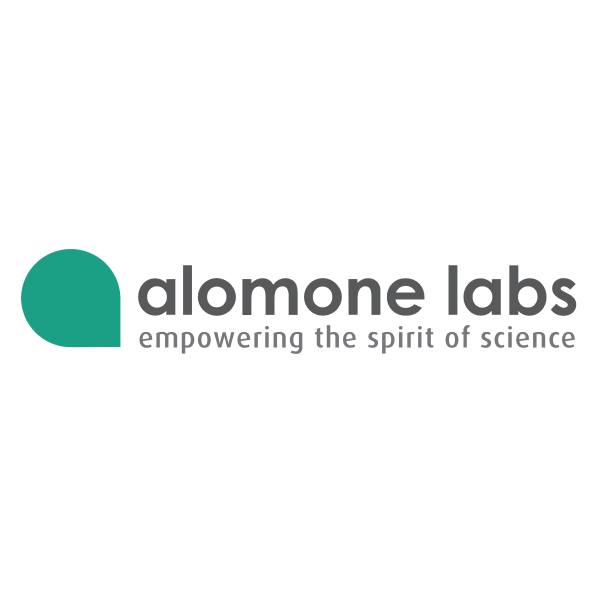

品牌: Alomone
 下载产品说明书
下载产品说明书 用小程序,查商品更便捷
用小程序,查商品更便捷



 收藏
收藏
 对比
对比 咨询
咨询纯度:
Affinity purified on immobilized antigen.
Affinity purified on immobilized antigen.
反应种属:
H, M, R
H, M, R
产品介绍
产品信息
纯化方式
Affinity purified on immobilized antigen.

宿主
Rabbit

免疫原
Peptide (C)DGPNAQVMNAEEH, corresponding to amino acid residues 46-58 of rat kainate receptor GluK3 (Accession P42264). Extracellular, N-terminus.

简单描述
A Rabbit Polyclonal Antibody to Kainate Receptor GluK3

商品描述
Alomone Labs is pleased to offer a highly specific antibody directed against an extracellular epitope of the rat kainate receptor GluK3. Anti-GRIK3 (GluK3) (extracellular) Antibody (#AGC-040) can be used in western blot and immunohistochemistry applications. The antibody recognizes an extracellular epitope and is thus highly suited to recognize the receptor in living cells. It has been designed to recognize GluR7 from human, rat and mouse samples.

同种型
Rabbit IgG.

纯度
Affinity purified on immobilized antigen.

形式
Lyophilized

组成成分
谷氨酸离子型受体红藻氨酸亚基抗体;磷酸盐缓冲液;防腐剂(0.05%叠氮化钠溶液)

基因
GRIK3

应用
实验应用
IF, IHC, WB

反应种属
H, M, R

背景
别名
Glutamate receptor ionotropic kainate 3, Glutamate receptor 7, GluR7

背景
Inotropic glutamate receptors (iGluRs) mediate the majority of fast excitatory synaptic neurotransmission in the central nervous system. The selective assembly of iGluRs into AMPA, kainate, and N-methyl-D-aspartic acid (NMDA) receptor subtypes is regulated by their extracellular amino-terminal domains (ATDs)1.
Kainate receptors (KARs) are tetramers classified into low-affinity receptor families (GluK1–GluK3) and high-affinity receptor families (GluK4–GluK5) based on their affinity for the neurotoxin kainic acid. KARs share a similar architecture with other ionotropic glutamate receptors; the subunits have a large extracellular domain composed of an amino-terminal domain (ATD) and a ligand binding domain (LBD) and an intracellular carboxy-terminal region2.
KARs are expressed in neurons and glial cells throughout the CNS. GluK3 is poorly expressed, appearing in layer IV of the neocortex and dentate gyrus in the hippocampus3.
KARs serve a crucial role as modulators of synaptic transmission and plasticity and their dysfunction has been linked to several disease states such as epilepsy, chronic pain and neurodegenerative diseases4. Alteration in the extracellular domain of GluK3, is in linkage disequilibrium with recurrent major depressive disorder patients5 and subjects with schizophrenia6.
Kainate receptors (KARs) are tetramers classified into low-affinity receptor families (GluK1–GluK3) and high-affinity receptor families (GluK4–GluK5) based on their affinity for the neurotoxin kainic acid. KARs share a similar architecture with other ionotropic glutamate receptors; the subunits have a large extracellular domain composed of an amino-terminal domain (ATD) and a ligand binding domain (LBD) and an intracellular carboxy-terminal region2.
KARs are expressed in neurons and glial cells throughout the CNS. GluK3 is poorly expressed, appearing in layer IV of the neocortex and dentate gyrus in the hippocampus3.
KARs serve a crucial role as modulators of synaptic transmission and plasticity and their dysfunction has been linked to several disease states such as epilepsy, chronic pain and neurodegenerative diseases4. Alteration in the extracellular domain of GluK3, is in linkage disequilibrium with recurrent major depressive disorder patients5 and subjects with schizophrenia6.

制备和贮存
溶解方法
25 µl, 50 µl or 0.2 ml double distilled water (DDW), depending on the sample size.

保存方式
The antibody ships as a lyophilized powder at room temperature. Upon arrival, it should be stored at -20°C.
数据库链接
Entrez-Gene ID
298521

UniProt ID
P42264

研究资源识别码
AB_2340955.

声明 :本官网所有报价均为常温或者蓝冰运输价格,如有产品需要干冰运输,需另外加收干冰运输费。







 危险品化学品经营许可证(不带存储) 许可证编号:沪(杨)应急管危经许[2022]202944(QY)
危险品化学品经营许可证(不带存储) 许可证编号:沪(杨)应急管危经许[2022]202944(QY)  营业执照(三证合一)
营业执照(三证合一)